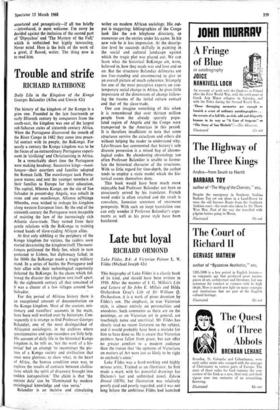Daily Life in the Kingdom of the Kongo Georges Balandier
(Allen and Unwin 42s)
Trouble and strife
RICHARD RATHBONE
Daily Life in the Kingdom of the Kongo Georges Balandier (Allen and Unwin 42s)
The history of the kingdom of the Kongo is a grim one. Founded in the late fourteenth or early fifteenth century by conquerers from the south-east, the kingdom was one of the largest sub-Saharan states of sixteenth century Africa. When the Portuguese discovered the mouth of the River Congo in 1482 they came into peace- ful contact with its people, the BaKongo. For nearly a century the Kongo kingdom was to be the focus of an extraordinary Portuguese experi- ment in 'civilising' and Christianising in Africa.
In a remarkably short time the Portuguese were making headway. Successive kings—mani- kongos—their courtiers and families adopted the Roman faith. The manikongos took Portu- guese names and sent the younger members of their families to Europe for their education. The capital, Mbanza Kongo, on the site of Sao Salvador in present-day Angola, was rebuilt in stone and one manikongo, Alfonso neNzinga Mbemba, even wished to reshape his kingdom along western European lines. By the end of the sixteenth century the Portuguese were incapable of resisting the lure of the increasingly rich Atlantic slave-trade. They turned from their gentle relations with the BaKongo to training armed bands of slave-raiding African allies.
At first only nibbling at the periphery of the Kongo kingdom for victims, the raiders soon started devastating the kingdom itself. The mani- kongos petitioned the Holy See, which in turn protested to Lisbon, but diplomacy failed; in the 1660s the BaKongo made a tragic military stand. In a series of battles the Portuguese and their allies with their technological superiority defeated the BaKongo. In the chaos which fol- lowed the disaster the kingdom tore itself apart. By the eighteenth century all that remained of it was a cluster of a few villages around Sao Salvador.
For this period of African history there is hit exceptional amount of documentation on the Kongo kingdom. Most of the sources, mis- sionary and travellers' accounts in the main, have been well worked over by historians. Con- sequently it is strange to find Professor Georges Balandier; one of the most distinguished of Africanist sociologists, in the archives where questionnaires and tape-recorders are little help. His account of daily life in the historical Kongo kingdom is, he tells us, 'not the work of a his- torian' but an attempt 'to reconstruct the pic- ture of a Kongo society and civilisation that once were glorious, to show what, in the heart of Africa, the human condition once was, to explore the results of contacts between civilisa- tions which the spirit of discovery brought into sudden juxtaposition.' The claim is that 'the ancient data' can be 'illuminated by modern sociological knowledge and vice versa.'
Balandier is an incisive and stimulating writer on modem African sociology. His out- put is staggering; bibliographies of the Congo look like the A-D telephone directory, so numerous are the entries under his name. In his new role he is less impressive. At the descrip-
tive level he succeeds skilfully in painting in the social and cultural landscape against which the tragic plot was played out. We can learn what the historical BaKongo ate, wore, believed in, how they made war and love and so on. But the structures Balandier delineates are too free-standing and unconnected to give us an overall picture of much coherence. Strangely for one of the most perceptive experts on con- temporary social change in Africa, he gives little impression of the dimensions of change follow- ing the trauma of the initial culture contact and that of the slave-trade.
One can imagine something of this when it is remembered that over thirteen million people from the already sparsely popu- lated region of Angola and the Congo were transported to the Americas in this period. It is therefore insufficient to note that some structures survive the cataclysm and others die without helping the reader to understand why. Livi-Strauss has commented that history's sole discrete possession is a mixed bag of chrono- logical codes. By abandoning chronology too often Professor Balandier is unable to formu- late the historical character of the structures. With so little regard for time-depth, the author tends to employ a static model which the his- torical events themselves deny.
This book would have been much more enjoyable had Professor Balandier not been so atrociously served by his translator. French word order is often retained and the result is convolute, Jamesian sentences of enormous pomposity. With such an inept translation one can only wonder if Professor Balandier's argu- ments as well as his prose style have been butchered.










































 Previous page
Previous page